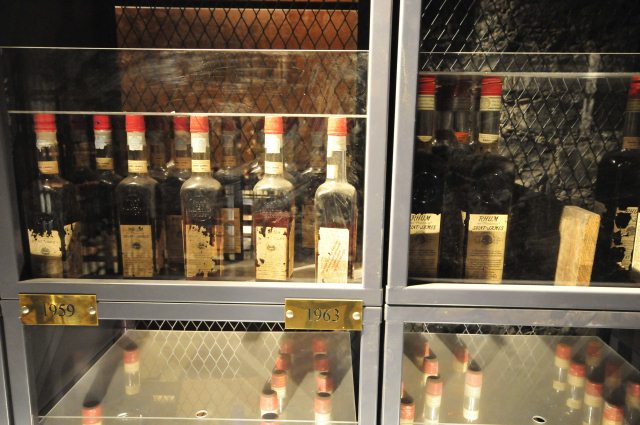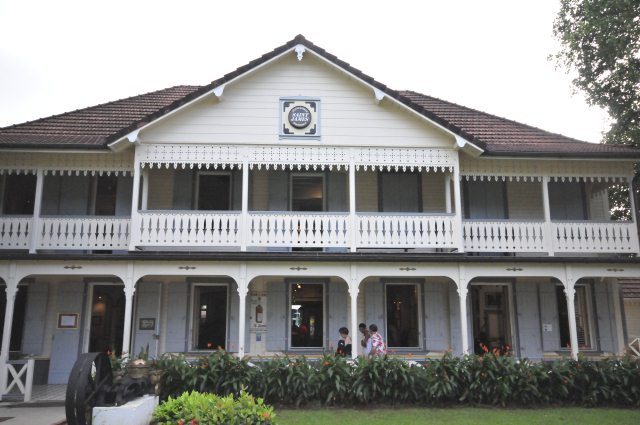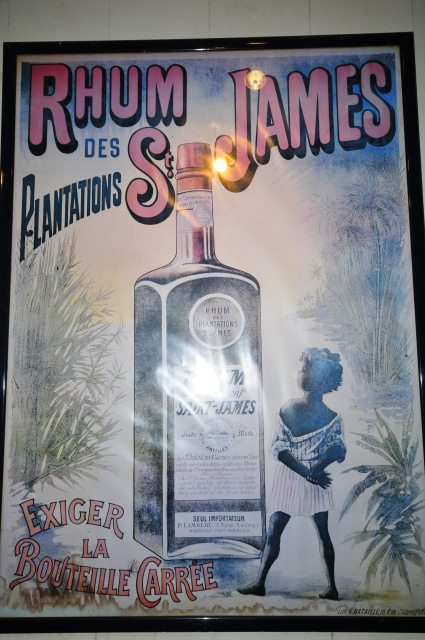No spuddle about on a Caribbean Island is complete without a little
look in a rum factory, today was to be no different - the rum St James. By the time colonists established a settlement on
Martinique, sugar was becoming the most valuable crop in the Caribbean. In 1765,
Saint James began making alcohol from the by-products of sugar production. Until
only two years before, it had been illegal to export rhum from the colonies to
France so ships loaded with molasses from the Saint James Sugar Factory in St.
Pierre were sailing to North American distilleries to be made into rum.
The sugar company continued to expand until the eruption of Mt.
Pelée, which destroyed the factory and distillery. Since then, Saint James has
relocated to the eastern side of the island but today, only alcohol is produced
from the sugar cane processed here. Opened to the public in 1981, the Saint
James museum, on the west side of the main road in Sainte Marie, is housed in
the mansion previously associated with the Sainte Marie Sugar Factory. On the
museum grounds, a collection of machinery documents the development of the
equipment used in the sugar industry over the last three hundred
years.
Inside, in the cool shade of this picturesque mansion are
smaller displays of equipment and photos of the sugar and distillery industry in
Martinique. A beautiful bar on the ground floor
offers samples of the rhums made here. Entrance to the museum is free, we were
too late for the official distillery tour, but found our way around with the
help of the bi-lingual signs and labels. Of course it would have been very bad
form not to sample.
One of the tour trains - we were too late
for
SAINT-JAMES was originally founded in Saint-Pierre on the "route de
Fonds Saint-Denis where, by order of the king on the 13th of August 1685, the
Tourvaillant Estate" or "Hopital" was established. The monks of the
"hospitaliers de la charite" order ran this institution. The estate reached its
pinnacle with Father Edmond Lefebrure, the order's superior. He built the sugar
refinery and, according to some sources, called the rum produced there
SAINT-JAMES. In 1765, this holy name, made it easier to sell rum to the
colonists of New England. Martinique was occupied by the English at the time. It
returned to French control during the Revolution and church property then
belonged to the state. Following the Treaty of Amiens which ended the English
presence in Martinique (between 1794 and 1802), the Trouvaillant National Estate
covered one hundred and sixty hectares, with buildings, equipment, slaves and
warehouses was rented to Monsieur Henry for nine years. Between 1809 and 1814,
Martinique was once more occupied by the English who took charge of the
property, now owned by the British Government. By Royal Order of the 8th of June
1820, the concession deeds were cancelled. The estate was sold by Royal Decree
on the 17th August 1827 to the SAINT-JAMES Rum Company. In 1829, the estate
owned one hundred and five slaves. From 1840; the factory used the new
continuous distillation process.
Typical adverts of the era featuring the slave
workers and a cute little black
child.
Circa 1845, a wine and spirit merchant from Marseilles, called
Paulin Lambert introduced Caribbean rum to the French market. He became one
of the biggest importers of this spirit distilled from molasses. The General
Council sold the estate and sugar refinery on the 20th of October 1860. It
became the property of Mr Paul des Grottes and his three sons: Victor, Edouard
and Eugene. Each owned one quarter of Trouvaillant Estate. In 1882, Paulin
Lambert filed the "rhum des plantations SAINT-JAMES" trademark at the commercial
court of Marseilles. He began to market it in the following year. He owned
offices and shops in Saint-Pierre. Until 1890, he was supplied by small local
Caribbean distillers. That year, he purchased the Trouvaillant Estate which he
re-named "Plantation Saint-James". On the 6th of September 1926, the company
became a limited company and its head office was transferred to Fort de France
in 1940. The rum was made at Trouvaillant and Acajou Estates until 1970. In the
meantime, the SAINT-JAMES rum trademark was taken over by the Cointreau company.
The factory was transferred to the old central factory of Sainte-Marie which
belonged to the Depointes family. The Union land at Sainte-Marie had practically
the same qualities as that at Saint-Pierre and the quality of the rum was
therefore maintained.

The distillery, next to the museum, is a large operation
that operates almost year round. Most of the cane processed here is grown by the
Saint James Company on its land; the remaining 20% is bought from local farmers.
At the distillery, the cane is shredded, then crushed in one of the four -
three-cylinder cane mills, which are capable of processing sixty tons of cane an
hour. During the cane season, the mills yield more juice than can be fermented.
Most of the fresh juice is pumped directly to the fermentation tanks. The rest
is filtered, then concentrated by vacuum to a syrup for storage. This is the
first step of sugar production, but the sugar is not crystallized as it would be
in the more refined process. After the cane season, the syrup is diluted to its
original consistency then fermented and distilled into alcohol.
After twenty-four to thirty-six hours of fermentation, the
fermented juice, or vin, is distilled in one of the six single-column stills.
Leaving the columns at 75º, all of the raw rhum is allowed to rest for six
months in one of twenty 68,000-liter stainless steel tanks. While the rhum is
resting, carbonic gas, formed during fermentation, is released and other
molecular changes take place. The rhum dismisses some of the tastes acquired
during distillation and becomes a more consistent and pleasing drink. After
resting, the rhum, which will be bottled as white rhum or Grappe Blanche, is
diluted with distilled water to reduce the alcohol content to 50º or 55º. If it
is to be bottled as Imperial Blanc Saint James, treated water is used to dilute
the rhum.

Some of the precious "old stuff"
Another portion of the
production is put in one of the many 35,000-litre wooden vats, or tuns, for 18
months. Here, the rhum attains a slight yellow colour and some components in the
rhum exchange chemical compounds with the wood, forming complex esters that also
add to the flavor. This rhum, bottled at 50º and 55º, is sold as Rhum Paille
Saint James. Finally, the last part of the production is put in 200-liter oak
barrels, where it is allowed to sleep. After three years, the Rhum Vieux Saint
James, bottled at 42% alcohol by volume, has a rich, brown colour with a mature
aroma and taste.


Bear found this snake on display, highly venomous and a distant relative of
the crocodile - even stuffed it made him sweat behind the knee caps. An advert
featuring the national hummingbird
Also
bottled at the distillery are Rhum Saint James Hors D’Age, a blend of several
aged rhums, and Rhum Ambre Saint James, a two-year-old rhum bottled at 45%
alcohol by volume. All of the Saint James rhums described above are bottled in
elegant, square bottles from Marseilles. Plantations Saint James Martinique is
embossed on the side of these distinctive bottles and makes for a nice
souvenirs, pleasant reminders of a popular Martinique rhum. In addition to the
rhum distilled in the single-column stills, a pot still, resembling the one
depicted on the label, is used to make small amounts of Coeur de Chauffe.
Originally heated by a wood fire, this still is now steam-fired to reduce the
fire hazard. Distilled from fresh cane juice, this rare rhum is bottled at 60%
alcohol by volume and only available at the distillery.
This is one of the few distilleries in Martinique that
utilises its equipment after June, the end of the cane-cutting season. The six
stills represent the second-largest distilling capacity on the island and are
employed to make alcohol from fermented molasses. All of these products are sold
to bottlers in France and elsewhere in the world.
















